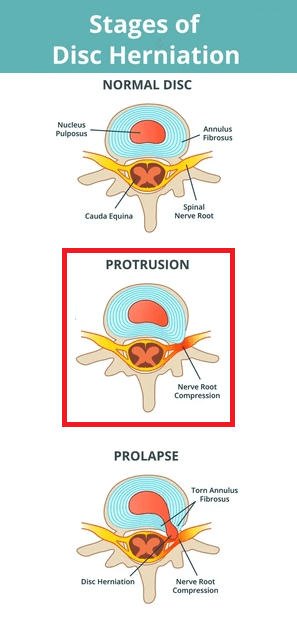Disc protrusions, also known as herniated discs or slipped discs, occur when the soft center of a spinal disc pushes through a crack in the tougher outer layer. This condition can cause a range of symptoms and problems, depending on the location of the disc and the severity of the protrusion. In this article, we will discuss what disc protrusions are, common locations for them to occur, examples of causes, symptoms, and problems they can cause, usual treatment options, and why chiropractic care is a great option for managing this condition.
What Are Disc Protrusions?
The spinal column is made up of a series of bones (vertebrae) that are cushioned by small, spongy discs. The discs act as shock absorbers for the spine and allow for flexibility and movement. When the soft center of a disc pushes through a crack in the outer layer, it can cause a disc protrusion. This condition can put pressure on nearby nerves and cause pain, numbness, or weakness.
Common Locations For Disc Protrusions
Disc protrusions can occur in any part of the spine, but the most common locations are the neck (cervical spine) and lower back (lumbar spine). In the cervical spine, a disc protrusion can cause pain and numbness in the arms and hands. In the lumbar spine, a disc protrusion can cause pain, numbness, or weakness in the legs and feet.

Common Causes Of Disc Protrusions
Disc protrusions can be caused by many factors, including age-related degeneration, injury, and wear and tear. As we age, the discs in our spine can lose their elasticity and become less flexible. This can make them more susceptible to damage and herniation. Injury or trauma to the spine, such as a fall or car accident, can also cause disc protrusions. Repetitive movements or heavy lifting can also increase the risk of disc protrusions.
Symptoms & Problems
The symptoms of disc protrusions vary depending on the location of the disc and the severity of the protrusion. Common symptoms include:
- Pain, numbness, or tingling in the affected area
- Weakness in the affected area
- Loss of reflexes
- Difficulty walking or standing up straight
Disc protrusions can cause a range of problems, including difficulty with daily activities, sleep disturbances, and emotional distress. In severe cases, surgery may be necessary to remove the protruding disc.
Usual Treatment Options
Treatment for disc protrusions typically involves a combination of rest, physical therapy, and pain medication. In some cases, surgery may be necessary to remove the protruding disc. Other non-surgical treatments may include spinal injections or chiropractic care.
Why Typical Chiropractic Care Is A Great Option
Typical chiropractic care is a non-invasive and drug-free treatment option that can help manage the pain and symptoms of disc protrusions. Chiropractors use manual manipulation techniques to realign the spine and reduce pressure on the affected nerves. This can quickly help reduce pain and increase range of motion and mobility. Chiropractic care also has no to minimal side-effects and is less expensive than most other treatment options.
In addition to manual manipulation, chiropractors may also use other complementary therapies, such as massage and stretching exercises, to help manage pain and improve function. They can also provide lifestyle advice to help prevent further damage to the spine.
Chiropractic Care Utilizing Zone Technique for Disc Protrusions
Any Zone Technique healer, including Dr. Post, knows exactly what to do for any condition walking into the office, including disc protrusions. Since Zone Technique is able to unlock and unleash the powerful healing ability withing your body, your healing results will be amazingly better than any other healing technique available today. Whether you have or someone else you know has one or more disc protrusions, balancing the body by utilizing Zone Technique will heal your body on a very deep level. Zone Technique healing is natural, effective, and permanent so that you will heal completely, function great and no longer have pain. You can be totally healthy again – feeling great and functioning perfectly from head to toe every day of the year!
If you don’t live close enough to see Dr. Post, search for a certified Zone Technique healer closer to you by searching the ZONE TECHNIQUE PRACTITIONER DIRECTORY. You owe it to yourself to take action so that you can heal and feel awesome again.
Conclusion
Disc protrusions can be a painful and debilitating condition, but there are many treatment options available. Typical chiropractic care is a safe, effective, and affordable option for managing disc protrusions. However, working with a chiropractor who is certified in Zone Technique you will function perfectly and feel amazing very quickly by fully healing your body. By working with a chiropractor, patients can reduce pain, improve mobility and function, and prevent further damage.

